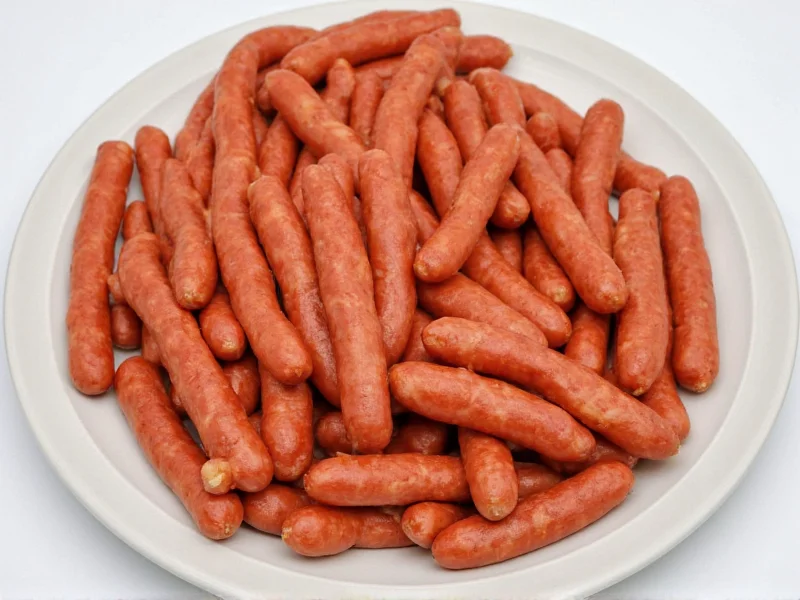Understanding Flat Sausage: Purpose and Preparation
When exploring the world of sausages, you'll encounter various shapes and forms, with flat sausage representing a deliberate culinary choice rather than an accident. Unlike traditional cylindrical sausages, flat varieties are intentionally shaped during preparation to create a thinner profile that cooks more evenly and develops superior texture.
The distinctive flat shape serves multiple practical purposes in cooking. Flat sausages achieve crispier exteriors while maintaining juicy interiors due to their increased surface area-to-volume ratio. This geometry allows for faster, more consistent cooking—particularly valuable when preparing breakfast items or incorporating sausages into sandwiches and wraps where uniform doneness matters.
Global Variations of Flat Sausage
Cultures worldwide have developed their own flat sausage specialties, each with unique preparation methods and flavor profiles:
| Sausage Type | Origin | Distinctive Features |
|---|---|---|
| Goetta | German-American | Oat-based mixture shaped into logs and sliced flat before cooking |
| Morcilla Tapas Style | Spanish | Blood sausage pressed flat for tapas presentation |
| Loukaniko Plaki | Greek | Lemon-herb sausage flattened for baking in tomato sauce |
| Flat Bratwurst | Midwestern US | Traditional brat pressed flat on the grill for faster cooking |
Why Flat Shape Matters in Cooking
The physics behind flat sausage preparation reveals significant advantages for home cooks and professional chefs alike. When sausages maintain their flattened shape through proper casing selection and filling techniques, they achieve several cooking benefits:
- Even heat distribution—eliminating the "raw center, burnt exterior" problem common with thick sausages
- Faster cooking times—reducing preparation time by up to 40% compared to traditional cylindrical shapes
- Superior browning—creating more Maillard reaction surface for enhanced flavor development
- Easier portion control—simplifying slicing for sandwiches, salads, and composed dishes
Professional chefs often employ specific techniques to maintain the flat shape during cooking, including using natural casings with appropriate tension, incorporating binding agents like breadcrumbs, and controlling cooking temperatures to prevent re-rounding.
Flat Sausage Cooking Techniques
Mastering flat sausage preparation requires understanding proper cooking methods. Unlike traditional sausages that benefit from indirect heat initially, flat varieties respond best to direct, moderate heat from the start:
- Preheat your cooking surface to 325-350°F (163-177°C) before adding sausages
- Avoid piercing during cooking to retain juices while allowing even heat penetration
- Flip only once midway through cooking to develop proper sear without disturbing shape
- Rest for 3-5 minutes after cooking to allow juices to redistribute
For best results with flat sausage cooking techniques, consider using cast iron or grill plates that maintain consistent temperature. These surfaces prevent the common issue of sausages shrinking and losing their flat profile during preparation.
Common Misconceptions About Flat Sausage
Many home cooks mistakenly believe flat sausage indicates a preparation error. In reality, properly made flat sausage maintains its shape through intentional design. The difference between a successfully prepared flat sausage and one that flattens unintentionally lies in several key factors:
- Casing selection—natural casings with appropriate diameter prevent re-rounding
- Filling density—properly stuffed sausages maintain shape during cooking
- Ingredient composition—binding agents help maintain structural integrity
- Cooking method—appropriate heat levels prevent casing rupture
When investigating why is my sausage flat after cooking, consider whether the flattening occurred during preparation (intentional) or during cooking (potentially problematic). Intentionally flat sausages maintain consistent thickness throughout, while accidentally flattened sausages often show uneven cooking and texture issues.
Practical Applications in Modern Cuisine
Contemporary chefs leverage flat sausage varieties in innovative ways that highlight their unique properties. The increased surface area makes them ideal for:
- Sandwich construction—providing even coverage without bulky centers
- Breakfast plates—cooking alongside eggs and potatoes with similar timing
- Pizza toppings—distributing flavor evenly without creating raised areas
- Salad components—slicing into uniform pieces for consistent bites
For those exploring flat sausage recipes for breakfast, consider how the shape allows for perfect pairing with pancakes or waffles—creating balanced flavor distribution in every bite without overwhelming other components.
Selecting and Storing Flat Sausage
When purchasing flat sausage varieties, look for these quality indicators:
- Consistent thickness throughout the length
- Firm texture without air pockets
- Moist but not wet surface
- Clear ingredient labeling
Proper storage maintains the integrity of flat sausage. Keep refrigerated below 40°F (4°C) and use within 2 days of purchase for fresh varieties, or follow manufacturer guidelines for pre-cooked options. When freezing flat sausages, separate individual pieces with parchment paper to prevent sticking while maintaining shape.
Frequently Asked Questions
What causes sausage to become flat during cooking?
Sausage becomes intentionally flat through preparation techniques including casing selection, filling density, and sometimes pressing during cooking. Accidental flattening typically occurs from overfilling, improper casing, or excessive heat causing casing rupture.
Is flat sausage a cooking mistake?
No, many flat sausages are intentionally prepared that way for specific culinary purposes. Traditional varieties like Goetta and certain tapas-style sausages maintain their flat shape through proper preparation techniques and serve distinct cooking advantages.
How do I prevent sausage from flattening unintentionally?
To maintain cylindrical shape, use appropriate casing size, avoid overfilling, cook at moderate temperatures (325-350°F), and flip only once during cooking. Proper filling density and quality casings help maintain shape throughout cooking.
What are the best cooking methods for flat sausage?
Flat sausages cook best with direct, moderate heat from the start. Use cast iron or grill plates at 325-350°F, avoid piercing, flip only once, and rest for 3-5 minutes after cooking. This approach maximizes browning while maintaining shape and juiciness.
Can I make regular sausage into flat sausage at home?
Yes, you can create flat sausage at home by gently pressing cooked sausages between two spatulas or using a grill press. For best results, choose sausages with natural casings and moderate fat content, and press carefully while cooking to maintain structural integrity.











 浙公网安备
33010002000092号
浙公网安备
33010002000092号 浙B2-20120091-4
浙B2-20120091-4